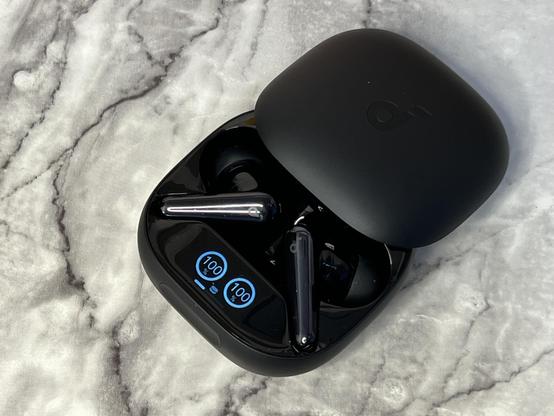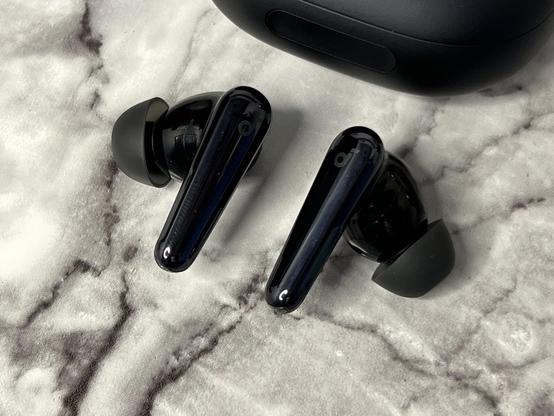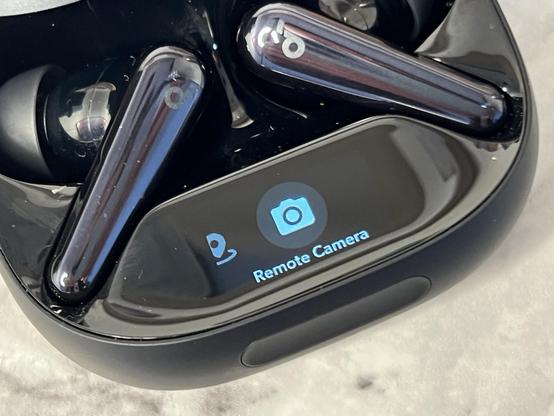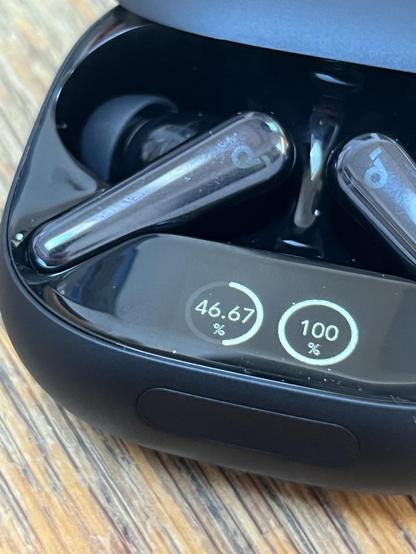Soundcore Liberty 4 Pro Noise-cancelling Earbuds Reviewed
When I reviewed Soundcore’s Space One Pro, I lamented that the Space One’s curved, sleek design and bold colours – something I really liked – had been lost in the “Pro” version. Soundcore’s Liberty 4 Pro seem to have gained those wayward sleek good looks and design touches, plus a whole bunch of colour choices in both matte and glossy finishes. And thus, balance is restored.
It doesn’t feel like so long ago that I tested the Liberty 4 NC, and I’m shocked to find that only just over a year has passed since I dived back into the world of earbuds. I was apprehensive at the time, since I can effectively only use one earbud, and this caused no end of problems back when earbuds were wired.
A screen feels a little exuberant but - as I learned from Plantronics/Poly - they are annoyingly useful 🤣 at a glance, unambiguous battery status for example!
But wires tugging an earbud out is not a problem with wireless. I quickly found that using one was better than using none, and earbuds are a lot less cumbersome a travel companion than over-ear (I struggle with smaller, on-ear headphones too, sigh) headphones.
Not to mention that, as a single-sided deafness sufferer, I have something unique to bring to my earbud reviews and can continue to bang the drum for more and better support for single earphone use cases.
In the year that passes, then, Soundcore have apparently set about improving every aspect of their Liberty earbuds, in a concerted effort to earn that “Pro” moniker. For the most part they have succeeded. To avoid beating around the bush Soundcore’s Liberty 4 Pro look better, sound better, punch harder, charge faster, and more besides. This premium set of features comes with a premium price, since the Liberty 4 NC are on sale the Liberty 4 Pro clock in at roughly double their price. Are they double as good? Let’s find out.
Look ‘n’ Feel
Not one to rest upon their laurels when it comes to design, Soundcore have changed more or less everything about Liberty 4 Pro compared to their non-pro predecessor. The case is palm-sized, roughly square and smooth like a pebble. With a gentle push on the top cover it slides open, revealing the headphones and the built-in display. This is very easy to do one-handed, and the case stays open when it’s opened (and shut when it’s shut). The mechanism is quite satisfying, like the earbud equivalent of a Zippo lighter.
They are similar to the Liberty 4 NC visually, but oh so very improved!
Water ingress protection has also received a bump from 4 to 5 (resistance against jets of water instead of just splashes), while this still doesn’t make any guarantees about full immersion – a real risk if your earbuds fall out into a puddle or otherwise – it’s a welcome improvement that should make the Liberty 4 Pro survive a hot shower or two, rather than just a rainy day. Of course, not willing to take this at face value I wore the 4 Pro in the shower- that three hour Tantacrul video about Facebook isn’t going to listen to itself- and they survived.
Sound
I lamented Soundcore’s Liberty 4 NC headphones as sounding a little muddy. I distinctly remember the sensation, a lack of clarity and separation between the various dynamics of the songs I was testing with. Not so with the Liberty 4 Pro, they sound clear and additionally punch a lot harder than others buds I’ve tested. That is, in real terms, to say they push out a rather surprising amount of bass if you want them to.
Sound is assisted by Soundcore’s app-driven EQ, which is much for muchness any other EQ but does include some useful presets. “Podcast” is by far the most useful, since I listen to podcasts a lot, and any extra help I can get to pick out speech without cranking the volume is very welcome. As with the Soundcore Space One and Pro there’s a whole customisation flow to generate an EQ profile tuned to your specific hearing. This works much like a hearing test, and Soundcore dub it HearIQ. You will, however, need to be logged into the app in order to take the test, which is a little irksome.
One huge improvement over prior hearing tests – which I’ve tried in a number of different headphones from different manufacturers – is a new “Warbling Sound.” This sound very much like an artificial vocalist, with a little vibrato which makes it very distinct from the high-frequency sound that characterises tinnitus. As a tinnitus sufferer who has struggled telling the difference between tinnitus and the sound I’m supposed to be listening for, this is a very welcome improvement. That said, hearing over the cacophony of sound in my head still proved difficult. Single-sided deafness sufferers will be relieved to know that you can test one ear and opt out of testing the other. This also marks the first time the hearing test has basically said “your hearing is shot, you should consult a professional.” Thanks, but I’ll keep waiting for commodity aids!
After another bout of Make It Come True to gauge your EQ preference you’ll have a customised-for-you profile that should make a noticeable difference to your music. In my case it very noticeably makes everything louder versus the typical Soundcore Signature EQ profile, fitting my preference toward crank-up-the-volume. This seems to lift virtually everything out of the mix, somehow, and it’s difficult to elucidate the improvement it makes to my listening experience without sounding like a charlatan.
Suffice to say, Soundcore’s Liberty 4 Pro are now my go-to earbuds.
Noise-cancelling is great, with a whopping ten levels between full transparency, through normal and up to full noise-cancelling. This could be useful for those who find full-blown noise cancelling uncomfortable, but I can’t be sure because I don’t. Or at least haven’t for many, many years. Disappointingly the automagic “Airplane Mode” (which compensates for air pressure) requires a connection to both buds to function… not so great for us single sided users, but I’m not planning any flights in a hurry. Oh well. Wind noise reduction is similarly affected, which is a little more irksome. Cranking up noise-cancelling to combat a windy day is one of my more frequent uses for noise cancelling, aside from drowning out various fan noises. The full range of noise cancelling options can be accessed via the case, too.
The Smart Case
Though it’s great to have some extra functionality in the case, and at-a-glance access to detailed battery information, I found the controls – or lack thereof – a little clumsy. The front edge of the case is a little touch slider which recognises left/right swipes, long presses and double-taps. With these you can negotiate through a basic on-screen menu that gives access to things like Bluetooth pairing (handy to be able to do this unambiguously), noise-cancelling level and even a remote shutter control for your smartphone camera.
A screen feels a little exuberant but - as I learned from Plantronics/Poly - they are annoyingly useful 🤣 at a glance, unambiguous battery status for example!
That is, at least, in theory. Perhaps it’s because I haven’t got used to the case yet, but I struggled to trigger swipes and double-taps reliably, and at first only discovered the long press by accident. It’s also quite tricky to use one-handed, with the screen itself – ironically – far better positioned to be a thumb-accessible input. On the upside, though, having a control that’s physically separate from the screen itself means you can see what you’re trying to interact with.
Via the mobile phone companion app you can also enable atmospheric pressure readout on the case, in addition to a “Find Device” feature, and “Spatial Audio.” The latter I’ve got no means of verifying since it requires stereo hearing, which is.. Uh.. not my forte. The case does allow me to activate Spatial Audio without wearing both earbuds, which is intriguing.
The new squareish, rounded, case is quite slick. The lid mechanism is snappy and satisfying.
If I were to level one complaint about the case it would be that I never quite know which way up I’m holding it in a hurry, trying to slide it open three different ways. Remembering that the USB Type-C port is along the back edge, and that the top slides backwards over it, is a good mnemonic. Or would be if I actually remembered.
Having a remote camera shutter trigger is an interesting value-add, and yes it actually works.
The App (or Accessibility, if you will)
If you’ve seen one earbuds or headphones or Bluetooth speaker app you’ve probably seen them all at this point. It goes without saying that Soundcore’s companion app lets you see battery information, control noise cancelling, and all the usual fare.
What isn’t a given, however, is the ability to rebind controls on both earbuds. In the case of the Liberty 4 Pro NC you can assign identical touch controls between both the left and right. This includes binding features you might normally find on a right bud over to the left one. This is great news for me (and maybe you, if you suffer from single-sided deafness of any description) because you can bind both Previous and Next to the same side, and still have two actions left over for Play/Pause and changing Noise-cancelling modes. Granted I find the touch actions quite tricky to trigger (better than doing it accidentally all of the time, I suppose), with a sort of pinch required.
You can also enable “Easy Chat” in the app, a feature that lowers music volume and turns on ambient sound pass-through when you start speaking- aimed at enabling you to converse naturally without removing the earbuds. Unfortunately you must have both earbuds inserted for this to work, which is somewhat disappointing. I’d love to know if there’s any technological limitation for this, or if it’s just assumed that someone with one earbud removed can actually hear a conversation- newsflash; I can’t!
As I mentioned above the slide-to-open case is handy for one-hand operation, though it’s such a regular shape that it’s tricky to reliably pick it up the right-way-up and I’ve tried to slide the lid open every wrong way at this point.
Fast Charging
On paper Soundcore claim that they’ve halved the time it takes to gain four hours of runtime, from the 10 minutes of the Liberty 4 NC down to 5 minutes in the Pro. Since seeing is believing, they’ve also included decimal places in the battery level reported by the case’s tiny LCD. This little flex is a nice touch, though it only shows up when you first drop an earphone into the case. The normal battery level is displayed to the nearest whole digit, and it still ticks up fast! But as fast as they claim?
The decimal places when you first pop an earbud into charge are a heck of a flex 🤣
I dropped the left earbud in at 58%, waited for ten minutes, and peeked at the battery level (displayed automatically when first opening the case) which had risen to 82%. That’s 24% or roughly one quarter a full charge in 10 minutes flat. If the 10 hour runtime on a single charge numbers are to be believed then that only translates to 2.4 hours. Or 1.2 hours in 5 minutes.
I can only assume, then, that they’re claiming the smart case itself charges quickly. Let’s try the test again. While the case doesn’t show a percentage for its own battery level, the app can be used to see one. I started at 60% (a reasonably arbitrary number) and I would expect fast charging to stop at around 80% in favour of slow, battery-friendly charging. Since the case ostensibly holds 40 hours of runtime, I’d predict a 10% charge over 5 minutes… does the maths check out?.. Well, uh, actually the earbud finished charging and the case itself (which was drawing 1.5W from my Anker power supply) discharged. Uhhh…
The earbud, then, had charged up 40% in just under half an hour, with a noticeable slowdown in the 90s. Pretty normal, then!
With the earbud now charged I repeated my case test, now starting at 40% – the first thing it did was immediately jump back to 60%… really not helping me draw any scientific conclusions here. This level was reflected by both the case and the mobile companion app.
Of course after five minutes the case had stubbornly refused to charge, remaining at 60%, though still somehow putting 1.5W *somewhere*. I closed the case this time and started another five minute timer. Fingers crossed?
Never has the phrase “a watched pot never boils” been truer than this very moment, but it wasn’t long until I realised that maybe, just maybe, the Gods of USB Type-C were angry at me and did not approve of my power supply -> cable -> device combination. Defeated, I swapped the case over to my laptop’s USB port and … wouldn’t you know … in just five short minutes it was suddenly claiming a whopping 60%. That’s 20% charge or 1/5th the total 40h capacity which would imply around eight hours. That’s suspiciously double the four hour claim, so perhaps this is the result of *two* 5 minute charges. Or perhaps I am doomed to chase my tail trying to verify what is – on the face of it – a very small and forgettable claim.
Just for giggles I stuck it on my laptop for another five minutes- if it’s at 80% I would theorise this (charging slows down when the battery is fuller) might get me to somewhere between 80-90%…. The charge level didn’t change at all. Well, uh, I guess 80% is between 80%-90%. It’s a small wonder everything charges wirelessly these days- much less hassle!
Despite all this fiddling, and I think it’s clear now why I don’t usually go out of my way to verify claims (when I can’t seem to even define them), one thing’s for sure- Liberty 4 Pro *do* charge fast. An observed 2.4 hours runtime from just 10 minutes in the case is nothing to sniff at, and the case itself seems to charge very quickly too.
Overall
With a great little case – the sliding lid and display are far more than just superfluous niceties – fantastic sound – whew, these are bassy! – and a somewhat single-sided deafness friendly approach to touch controls, the Liberty 4 Pro are a great choice. While I personally prefer earbuds without big dangly stems, there’s a lot to be said for having a little handle to grasp them by. With just the stock tips they are surprisingly comfortable and secure in my… ear… These earbuds bring all the mod-cons you might want from the back-end of 2024, at a more competitive price than some of their contemporaries, delivering a solid, all-round experience.
Grab them from Amazon for, at time of writing, £129.99. Is it just me, or does the green colour look niiiiicee?




